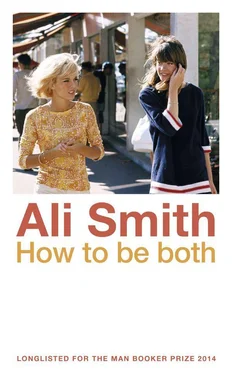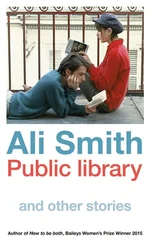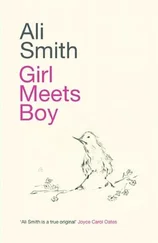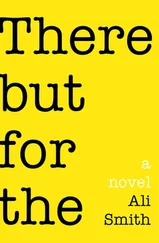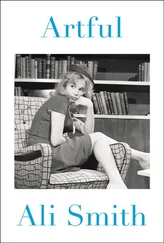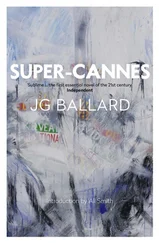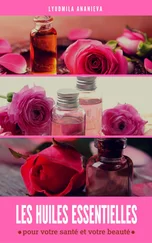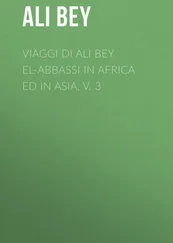Jackets what? George says.
Jackets in this year’s disease came of rawness, H says again. I wrote it down exactly. That’s what it said.
She reads another bit.
The few early works do not leave almost predict doing compositions so innovative imaginative —
then she says a word that sounds like annoy or paranoia.
She shows it to George on the page.
— so innovative imaginative Schifanoia .
That’s it. That’s the place we went to, George says when she sees the word.
(Her mother is saying it next to her in the car in Italy right now, months ago. It is the place to which they are on their way.
Skiff. A. Noy. A. , she is saying. Translated, it means the palace of escaping from boredom.
I’ll be the judge of that, George is saying back.
They pass a roadsign that makes George laugh because it points the way to somewhere called Lame.
They pass another. It says
Scagli di vivere
non berti la
vita
Is that what it said? Something to live, not something the life? It went past so fast.)
H has decided that they could do the empathy / sympathy exercise about this painter precisely because there’s so little known about him. This means they can make a great deal of it up and not be marked wrong because nobody will know either way.
Yeah, but will Maxwell expect us to do all that dreary historical imagine you are a person from another time stuff? George says. Imagine you are a medieval washerwoman or wizard who’s been parachuted into the 21st century .
He’d speak like from another time, H says. He’d say things like ho, or gadzooks, or egad.
I don’t think they knew about the word ho, I mean about what it means in rap songs, in Italy in the whenever it was, George says.
I expect they had their own word for it, H says.
George goes upstairs. She goes into her mother’s study and gets the dictionary off the shelf. In it, it says ho was already a word in 1300 when it meant an exclamation of surprise and also the call of a boatman. Now, apart from a prostitute and a shout of laughter, it can stand as a police term for a Habitual Offender and as a government term for the Home Office.
Ho ho ho, H says. Lots of ho’s in Shakespeare. Heigh-ho, green holly. Most friendship is feigning, most loving mere folly.
(H worked last year at the Shakespeare Festival in the summer as a ticket-seller and cleaner-upper for £10 a night.)
Wouldn’t it be better if we just imagine him talking like we do? George says. More empathetic?
Yeah, but the language would definitely have been different, H says.
Yeah, it’d have been Italian, George says.
But Italian then , H says. The way they said things then. Which would be different from it now. Imagine. Him wandering in his whatever they wore up and down the stairs in, I don’t know. The multi-storey. What would he make of cars?
Little prisons on wheels, George says.
Little confessionals on wheels. Everything for him would’ve been about God, H says.
That’s good, George says. Write that down.
He’d be like an exchange student, not just from another country but from another time, H says.
He’d be all alas I am being made up really badly by a sixteen-year-old girl who knows fuck all about art and nothing at all about me except that I did some paintings and seem to have died of the plague , George says.
H laughs.
You can’t just make stuff up about real people, George says.
We make stuff up about real people all the time, H says. Right now you’re making stuff up about me. And I’m definitely making stuff up about you. You know I am.
George blushes, then is surprised to find she’s blushing. She turns away. She thinks something else quick; she thinks how typical it’d be. You’d need your own dead person to come back from the dead. You’d be waiting and waiting for that person to come back. But instead of the person you needed you’d get some dead renaissance painter going on and on about himself and his work and it’d be someone you knew nothing about and that’d be meant to teach you empathy, would it?
It’s exactly the kind of stunt her mother would pull.
There’s an advert on TV right now for life assurance and someone’s dressed up as a plague victim in that, because the advert wants to suggest that its life assurance company has been around for centuries and that nothing’s not insurable.
But what would it have been like, she wonders, to die of plague? To be buried in a pit full of other people’s bones, someone fearful of catching it shovelling you in before you’re even cold, then shovelling all the other dead people on top of you? For a moment she thinks of bones under a cold floor, under flagstones in a church maybe, or under nondescript town buildings that people are living and working in right now with no idea that the bones are there below them. The bones agitate. They shift amongst themselves at her imagining them. They’re the bones of the man who painted that truly shocked duck with the hunter’s fist round its neck, painted the gentle eye of the horse, the woman who could float in the air above the back of the sheep or goat with its cheeky face, that strong dark man in the rags her mother found so astonishing and which H has brought up on to the screen right now.
It’s kind of better in real life, George says.
It says online it’s an allegory for laziness, H says. I suppose because his clothes are torn and he looks poor.
If my mother were still alive she’d make a Subvert out of them saying that, George says. She’d have a heart attack if she heard someone call that picture laziness.
The same place it says he’s an allegory of laziness, it also says this one’s an allegory of activity, H says.
She brings up the picture of the rich youth with the arrow in one hand and the hoop in the other.
I mean if she weren’t already, you know, dead, George says. I saw that one there too. Along from the ragged man. In the flesh.
H has also found three other pictures by this painter, which aren’t in the Ferrara palace. There is one in which an angel is kneeling to tell a Virgin Mary she’s going to give birth. Above them both, far away in the sky, there’s a floating shape. It’s God. He is shaped oddly, like a shoe, or a — what?
Then George notices a painted snail at the bottom of the picture, crossing it as if it’s a real snail crossing a picture. The snail shape is nearly the same as the God shape.
Does that mean that God is like a snail? Or that a snail traversing a picture is like God?
It has a perfect spiral in the shell.
Another is a bright gold picture. It is of a woman holding a thin-stemmed flower. The flower has eyes instead of flowerheads.
Wild, H says.
The woman holding the flower-eyes is smiling very slightly, like a shy magician.
The last picture H has found is of a handsome man with brown eyes. He is holding a gold ring. He is holding it like his hand is coming right out of the picture over the edge of its frame and into the real world like he’s literally saying, here, it’s for you, do you want it?
He is wearing a black hat. Perhaps he is in mourning too.
Look at that, H says.
She points to the rock formations in the background, behind the man’s head, where an outcrop of rock shaped a bit like a penis is pointing directly at a rocky bank opposite — across a small bay and on the other side of the handsome man’s head — which has an open cave set back in it.
Both girls burst out laughing.
It is both blatant and invisible. It is subtle and at the same time the most unsubtle thing in the world, so unsubtle it’s subtle. Once you’ve seen it, you can’t not see it. It makes the handsome man’s intention completely clear. But only if you notice. If you notice, it changes everything about the picture, like a witty remark someone has been brave enough to make out loud but which you only hear if your ears are open to more than one thing happening. It isn’t lying about anything or feigning anything, and even if you weren’t to notice, it’s there clear as anything. It can just be rocks and landscape if that’s what you want it to be — but there’s always more to see, if you look.
Читать дальше
